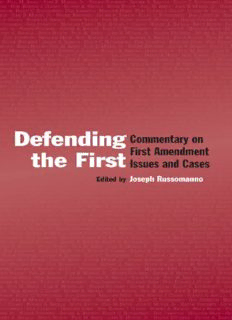
Defending the First: Commentary on the First Amendment Issues and Cases (Lea's Communication) PDF
Preview Defending the First: Commentary on the First Amendment Issues and Cases (Lea's Communication)
DEFENDING THE FIRST LEA’s Communication Series Jennings Bryant/Dolf Zillmann, General Editors SelectedtitlesinMassCommunication(AlanRubin,AdvisoryEditor)include: Alexander/Owers/Carveth/Hollifield/Greco•Media Economics: Theory and Practice, Third Edition Bryant/Bryant•Television and the American Family, Second Edition Harris•A Cognitive Psychology of Mass Communication, Fourth Edition Kundanis•Children, Teens, Families, and Mass Media: The Millennial Generation Moore•Mass Communication Law and Ethics, Second Edition Palmer/Young•The Faces ofTelevisualMedia: Teaching, Violence, Selling to Children, Second Edition Perse•Media Effects and Society Russomanno•Speaking Our Minds: Conversations With the People Behind Landmark First Amendment Cases Valkenburg•Children’s Responses to the Screen: A Media Psychological Approach VanEvra•Television and Child Development, Third Edition For a complete list of titles in LEA’s Communication Series, please contact Lawrence Erlbaum Associates, Publishers at www.erlbaum.com DEFENDING THE FIRST COMMENTARY ON FIRST AMENDMENT ISSUES AND CASES Edited by Joseph Russomanno Arizona State University LAWRENCE ERLBAUM ASSOCIATES, PUBLISHERS 2005 Mahwah, New Jersey London Dedicated to the spirit of freedom of expression and to those willing to fight for it yesterday, today, and tomorrow. This edition published in the Taylor & Francis e-Library, 2008. “To purchase your own copy of this or any of Taylor & Francis or Routledge’s collection of thousands of eBooks please go to www.eBookstore.tandf.co.uk.” Copyright © 2005 by Lawrence Erlbaum Associates, Inc. Allrightsreserved.Nopartofthisbookmaybereproducedin any form, by photostat, microform, retrieval system, or any other means, without prior written permission of the pub- lisher. Lawrence Erlbaum Associates, Inc., Publishers 10 Industrial Avenue Mahwah, New Jersey 07430 www.erlbaum.com Cover design by SeanSciarrone Library of Congress Cataloging-in-Publication Data Defending the First : commentary on First Amendment issues and cases / edited by JosephRussomanno p. cm. Includes bibliographical references and index. ISBN 0-8058-4925-4 (cloth :alk. paper) 1. UnitedStates.Constitution.1stAmendment.2.Freedomof speech—UnitedStates.3.Freedomofthepress—United States. I.Russomanno, Joseph. KF4770.D44 2004 342.7308’53—dc22 2004056425 CIP ISBN 1-4106-1350-X Master e-book ISBN CONTENTS Foreword vii NadineStrossen Preface xv 1 Creating a New First Amendment Right: Miami Herald 1 Publishing Co. v. Tornilloand the Story of Access to the Media Jerome A. Barron 2 Whose First Amendment? Cohen v.CowlesMedia Co. 23 Elliot C.Rothenberg 3 Freedom of Speech: A Casualty of War 45 Dan Johnston 4 The “Miracle” of Burstynv. Wilson 61 MarjorieHeins 5 Suppressing Hateful Ideas By Force of Law: Reflections 85 on R.A.V. v. St. Pauland Virginia v. Black Edward J.Cleary 6 Anatomy of an Oral Argument 111 Rodney A.Smolla 7 A First Amendment Life 139 Bruce S.Rogow v vi CONTENTS 8 The First Amendment in the Age of the Internet: The 163 U.S. Supreme Court Takes on the Challenge of a New Communication Medium Paul M. Smith 9 The Past, Present, and Future of Internet Censorship 185 and Free Speech Advocacy John B. Morris, Jr. Table of Cases 203 Index 207 FOREWORD Nadine Strossen1 DefendingtheFirstisanenlighteningcollectionoffascinatingfirst-handaccounts ofsomerecentmajorfreespeechcases.Eachessayisacompellingnarrativeinits ownright,andtogether,theyallunderscoreimportantconclusionsandongoing questionsaboutFirstAmendmentprinciples,especiallywhenviewedthrough the lens of Joseph Russomanno’s thought-provoking introductions to each chapter.Eachoftheseintroductionsmanagestoframecomplexlegalquestions withremarkableconciseness—thisbookshouldprovideanexcitingintroduc- tionfortheFirstAmendmentneophyte.Additionally,forFirstAmendmentex- perts, this work offers a stimulating re-examination of timeless concerns. AlthoughIwasthoroughlyfamiliarwiththecasesandissuesdiscussed—because Ihavetaughttheminmyconstitutionallawclasses,andtheACLUwasdirectly involvedinalmostallofthecases,Istillgainedvaluablenewinsightsfromeach chapteranditsthoughtfulintroduction.Inshort,nomatterhowlittleorhow muchFirstAmendmentbackgroundanyreadermightbringtothisbook,heor sheshouldfinditilluminating,aswellasengaging. NO FIGHT FOR FREE SPEECH EVER STAYS WON TheACLU’sprincipalfounder,RogerBaldwin,observedthat“Nofightfor civillibertieseverstayswon.”2DefendingtheFirstunderscoresthatimportant insightinthefreespeechcontext.Forexample,DanJohnston’schapterex- plainshowthecaseofTinkerv.DesMoinesIndependentCommunitySchoolDis- trict3 (in which he was acting as a “cooperating attorney” for the ACLU’s 1Professor of Law, New York Law School; President, American Civil Liberties Union. 2LindseyGruson,SecondThoughtsonMomentsofSilenceintheSchools,N.Y.TIMES,Mar.4, 1984, at 6E. 3393 U.S. 503 (1969). vii viii FOREWORD Iowaaffiliate)constitutesnotanewvictoryforstudents’freespeechrights inwartime,butratherareaffirmationofearliersuchvictories.Evenso,Tin- ker still deserves its usual accolade as a “landmark” case, because we can nevertakeforgrantedthattheSupremeCourtwillupholdbasicconstitu- tional liberties, including free speech rights, in times of war or other na- tionalcrisis—especiallywhenthespeakersarepoliticallypowerless,asisthe case with students too young to vote. Consistentwithournation’shistoricalpatternofsuppressingdissenting voicesduringwartime,Tinker’sreaffirmationofstudents’righttocriticizethe government’s war policies has not “stayed won” in the nation’s ongoing post-9/11“WaronTerrorism,”asindicatedbyamorerecentACLUcase,on behalfofMichiganhighschoolstudentBrettonBarber.In2003,BretBarber was disciplined for wearing a T-shirt with a message criticizing President Bush’sIraqpolicies,despitethefactthatBretexpresslycitedtheTinkerpre- cedenttohisschoolofficials.AlthoughBretBarber’srightswereultimately vindicatedincourt,4itisstilldisturbingthathisschoolauthoritiesdidnotvol- untarily honor the longstanding First Amendment principles at stake. Ac- cordingly,DanJohnston’scommentconcerningtheTinkerstudentplaintiffs remains true today concerning Bret Barber and other student plaintiffs: “The failure of their school authorities…to recognize [their free speech rights]demonstratesthefragilityoftheruleoflawintimesofwar.” InadditiontoDanJohnston’schapter,thechaptersbyMarjorieHeins,Ed- wardJ.Cleary,RodneyA.Smolla,BruceRogow,PaulM.Smith,andJohnB. Morris,Jr.,alsoallbearwitnesstothenecessityofregularlyrefightingoldfree speechbattlessothattheycan“staywon”innewcircumstances.Foronething, theHeins,Smith,andMorrischaptersillustratetheconstantstruggletoensure that courts and other government officials will apply the First Amendment’s guaranteeof“thefreedomofspeech”tonewmediaforconveyingspeech.As MarjorieHeinsremindsus,whentheSupremeCourtfirstconsideredachal- lengetocensorshipofthethen-newfilmmediumin1915,theCourtconcluded thatmoviesdidnotconstitute“speech”thatisshelteredbytheFirstAmend- ment.5Evenmoreastonishing,fromourcurrentvantagepoint,isthefactthat theCourtdidnotoverturnthatrulinguntilfourdecadeslater,in1952,whenit finallyacknowledgedthatcinemais“asignificantmediumforthecommunica- tionofideas”6andhencesubjecttoFirstAmendmentprotection. Likewise,PaulSmithandJohnMorrisremindusthatwhentheInternet burstontothepublicandpoliticalradarscreenlittle morethanadecade ago,thegovernmentstronglyarguedthatitconstitutedonlysecond-class speech,subjecttostrictgovernmentregulationofitscontent,similartothat imposed on the broadcastmedia. Although the Supreme Court resound- 4Barber v. Dearborn Public Schools, 286 F. Supp. 2d 847 (E.D. Mich. 2003). 5Mutual Film Corp. v. IndustrialComm’nof Ohio, 236 U.S. 230 (1915). 6Burstyn v. Wilson, 343 U.S. 495, 505-06 (1952). FOREWORD ix inglyrejectedthatgovernmentargumentinitsunanimousrulinginRenov. ACLU7 that ruling was not at all a foregone conclusion, given the Court’s pastreluctancetobringnewmediafullyintotheFirstAmendmentfold,as evidenced by its treatment of both film and broadcasting. TheHeinschapterillustratestheconstantstruggletoprotectfreespeech notonlyinemergingnewmedia,butalsofromreligiouslymotivatedcen- sorship.Althoughherchapterfocusesonthesuppression offilmcontent fromthe1930suntilthe1950s,inresponsetopressurefromtheCatholic Church, she also cites several much more recent examples—from 1988 through 2002—of religiously inspired suppression of artistic expression. Evenmorerecently,in2004,theFederalCommunicationsCommission actuallyincorporatedreligiousconceptsintoitsbroad,vaguedescriptionof indecent expression that is barred from the broadcast media. The FCC’s standardsforforbiddenbroadcastindecencynowproscribeanythingthatis profane.Thistermexplicitlyharksbacktonotionsofblasphemyorsacrilege, such as those that animated the 1951–1952 crusade against Roberto Rossellini’s acclaimed film The Miracle, which Heins recounts. Moreover, thebanonbroadcastprofanitywasadoptedinresponsetoaconcertedcam- paign by leaders of the so-called “Religious Right” for the FCC to crack downonbroadcastexpressionthatoffendstheirreligiousandmoralsensi- bilities.ThiscampaignwasstimulatedbythebriefflashofJanetJackson’s breast during the January 2004 televised Super Bowl halftime show. Stillmorerecently,inthewakeofthe2004elections,withsomepollsindi- cating that “moral values” may have played a decisive role in many voters’ minds,“ReligiousRight”organizationsandspokespersonshaverenewedtheir calls for further restrictions on expression that they deem inconsistent with their moral or religious values. Therefore, the kinds of religiously inspired threatstofreeexpressionthatHeinsdescribesarelikelytobeofasmuchcon- cernintheimmediatefutureastheyhavebeeninthemoredistantpast. BruceRogow’schaptercitesmanyexamplesofgovernmentofficialsvio- latingwhatformerSupremeCourtJusticeWilliamBrennantermedthebed- rock principle8 of our free speech law: the concept of content neutrality or viewpoint neutrality, which holds that government may never limit speech just because any listener—or even, indeed, the majority of the commu- nity—disagrees with or is offended by its content or the viewpoint it con- veys.Accordingly,asRogow’schapterchronicles,herepeatedlyhadtofight forthisfundamentalfreespeechpreceptincasesinvolvingexpressionthat wasoffensivetoparticularpoliticallypowerful,vocalconstituencies,rang- ing from Republican Party leaders who were offended by David Duke’s whitesupremaciststatements,toCuban-Americanswhowereoffendedby 7521 U.S. 844 (1997). 8Texas v. Johnson, 491 U.S. 397, 414 (1989).
Description: